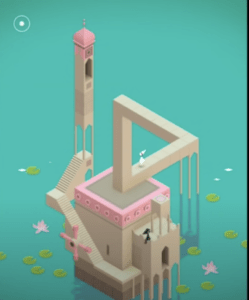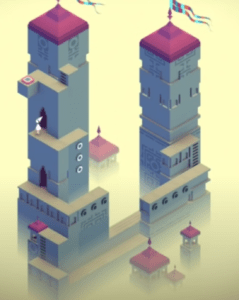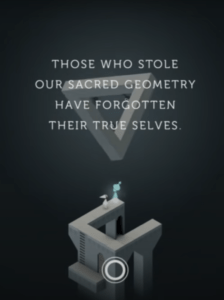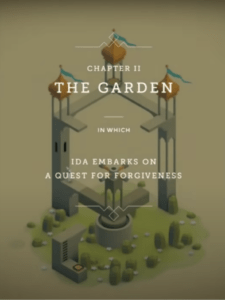The game I chose was Monument Valley, developed by Ustwo on iOS. The audience is anyone 8+ as it is relatively simple to begin gameplay; it is a universal game in a sense, playable by almost anybody. 
The goal of the game is to figure out how to move through 10 dynamic levels such that princess Ida can progress forward. It’s a 3D puzzle which involves stepping on  chambers, sliding things, rotating them, tapping, and moving through doors. These involve sequence puzzles and mazes, involving a lot of kinesthetic movement. This mechanic makes the digital world experience feel a lot more physical.
chambers, sliding things, rotating them, tapping, and moving through doors. These involve sequence puzzles and mazes, involving a lot of kinesthetic movement. This mechanic makes the digital world experience feel a lot more physical.
In addition, the aesthetics of the game make for an incredibly immersive experience in Princess Ida’s world. There is enough familiarity in the architechture such that clues can be revealed, and yet, since its a digital world, objects can be manipulated in otherwise impossible ways, such as the “Impossible Triangle” as seen in some of the images. Since the aesthetic and narrative rely on a geometric appeal, these clues are not completely out of the blue, but do pose an extra challenge to one’s thinking. Things fold and unfold in ways you wouldn’t expect them to; you can even rotate things to reveal hidden puzzle parts. In this way, the game is very challenging.
The main type of fun is the challenge of solving the puzzle— figuring out how to move the elements such that Ida can progress, avoiding the crows blocking you. There is also some fun from narrative, discovery, and exploration; each level begins with a storybook description, and as you progress further the blue figure tells you more and more about the “sacred geometry” world.

The way in which things move is also fascinating to interact with and explore, in addition to being helpful to solve each puzzle.
Additionally, there are sound effects serving as supportive mechanics that help to indicate “moveable” elements or obstacles like crows. The gorgeous animation is accompanied by a gorgeous soundtrack, fitting
for such a world. Furthermore, a cohesive and mysterious narrative helps to encourage the player to keep on playing the puzzle. The geometric nature of the game matches up with the “sacred geometry” narrative as well. There is much alignment between the puzzle mechanics, game narrative, and architecture which makes you want more and more of the physical puzzles but also narrative puzzle and resolution. In this respect, I’d say the puzzle met its goals.
As for things to make the game better, I would probably offer additional hints to players. It’s very tempting if things get frustrating, to just explore the world and give up. Lots of hints would hopefully encourage users to progress forward in addition to exploring the beautiful game that is Monument Valley.



